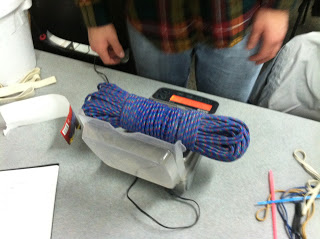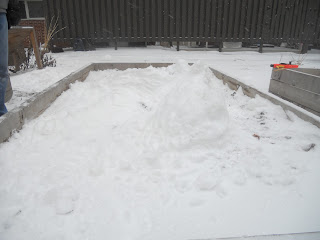The objective for this lab was to conduct a survey of point data in a quarter hectare using the distance and azimuth from a given origin. Mitch Collins was assigned to be my partner for this project. The point data could be collected in two different ways: using a range finder for the distance and a compass for the azimuth, or using a more high-tech TruPulse laser range finder that measures both. This project was conducted in two parts. The first was during class on February 18th, where the procedure, concepts, and equipment was introduced. The final data collection occurred on February 24th with my partner. In class, the concept of magnetic declination was discussed. Magnetic declination is the angle between magnetic north (direction in which a compass points) and true north (direction in which the north pole is located along the Earth's axis). Magnetic declination varies depending on the location on Earth, as well as over time. It is important to be aware of and adjust for it because it affects navigation. Here is a link to a webpage on the National Oceanic and Atmospheric Administration's website that calculates the magnetic declination based on location.
http://www.ngdc.noaa.gov/geomagmodels/Declination.jsp
The zip code for Eau Claire, WI was put in, and it was found that the city has a declination of 0° 58' W. This is a very small declination, and means that magnetic north lies 0° 58' counter-clockwis of true north.
Methodology
As mentioned before, the first part of this lab activity took place in the classroom, where the concepts and equipment were introduced. After this, the class went outside behind Phillips Hall and practiced using the equipment to obtain the distance and azimuth of objects. The location of this practice can be seen in Map 1. As you can see, this area is located between Phillips Hall and the parking lot. In this area, the TruPulse laser rangefinder and a compass and sonic rangefinder were used to take points of objects such as trees, signs, and sculptures. The tree near the corner of the building was designated as the origin. The origin can be found using a GPS device, or by using a recognizable feature that can be found on a high resolution aerial image.
 |
| Map 1. Practice Run with Equipment for Distance and Azimuth Survey |
During this trial, each group got a turn using the equipment, and recorded the distance and azimuth for a few points. This data was then stored in an Excel file brought into ArcMap. Two tools were then used to transform the tabular data into points on a map that correctly model a position. The first is Bearing Distance to Line, located under Data Management Features-->Features. This tool creates a line representing the distance and azimuth from the origin. When attempting to use this tool, many people in the class were having troubles. Help menus were searched, and by trial and error, a solution was found. The first step in this process is to create a geodatabase. The Excel file must then be imported into that geodatabase. To ensure accuracy, the cells containing the coordinates for the origin were formatted to show all of the decimal places. After the Excel file was imported into the geodatabase, the Bearing Distance to Line tool was able to be used successfully. The final tool to be used was Feature Vertices to Points, also located under Data Management Features-->Features. This tool placed a point at the end of each vertices that was created using the Bearing Distance to Line tool.
On our actual survey day, Mitch and I chose to do an area at the edge of the Hibbard parking lot along State Street.
 |
| Map 2. Locator Map of Study Area of Parking Lot along State Street |
 |
| Image 1. Location of Origin |
 |
| Image 2. View of State Street and Edge of Parking Lot from Origin |
 |
| Table 1. Distance and Azimuth Data |
 |
| Map 3. Results of the Bearing Distance to Line Tool |
 |
| Map 4. Results of the Feature Vertices to Points Tool |
 |
| Map 5. Final Map showing Point Data |
Discussion
Our study area consisted of the end of the Hibbard parking lot, as well as the nearby areas along State Street and Garfield Avenue. Our points consisted mainly of bare trees, bushing extending up from the snow, and street signs. We also measured the slope distance and azimuth to the stop lights surrounding the intersection. After examining Map 5, it was noticed that some of the points on the aerial image did not match up with the objects in real life. Most of these points are located in the middle of State Street, which runs north to south on the map. We did not take any points in the street, as most of the points were of trees or signs that were located along both sides of the street. These points appear to be between five and ten meters away from their expected locations. This might be attributed to the laser moving past a sign, tree, or bush and instead measuring the distance to a given spot on the road. An error in the recording and entry of data could also attribute to this problem. The point that is furthest north on the map certainly appears to be an outlier. There also is the chance that the aerial image is slightly distorted and is the cause for some of the anomalies.
The evolution of technology can be seen when examining the equipment that could be used to conduct a survey of points. The first method described involves using sonic rangefinders and a compass. This would require a second person to move to the desired points to collect the data. It would not be a very fast and efficient method if only one person was sent to survey the area. Another issue could be the precision with which the azimuth is measured using a compass. Using the TruPulse was a much faster and easier method of conducting the survey. It quickly switches between measurements modes to make a wide variety of measurements. It also has Bluetooth to transfer data. One of the downsides of a TruPulse is its expensive price. These two methods have been in large part, become outdated by GPS technology. GPS units allow a person to quickly move between objects and capture points. These can then be easily transferred to a computer for analysis. One of the negatives associated with using GPS is the idea that technology can fail a person at any time. There could be software and equipment issues, or loss of power, making the understanding of low-tech methods of surveying important when in a bind. GPS surveying is also not always an option due to location and topography. An accurate signal is not always attainable near tall buildings or under tree cover. Therefore, the use of a TruPulse laser rangefinder would be ideal for surveying objects in a forest or another area where a GPS signal is unreliable.
Conclusion
This lab was a great experience to see how surveying point data could be accomplished without the use of GPS technology. This process has evolved from using sonic rangefinders and a compass to a laser rangefinder that has many different measurement modes. Although using GPS would be the easiest way to survey an area, it can not always be trusted. During the process of loading the data that we collected into ArcMap, we encountered some problems with getting the Bearing Distance to Line tool to work. Through the consultation of online resources, as well as the collaboration of other students, we were able to work through this issue and display our results. Finally, we were able to display the points that were derived from the distance and azimuth data that we measured on top of an aerial image. This allowed us to compare our data points to the features that are visible in the image. This showed good results for the most part, although it does appear that nine of the 50 points are incorrectly located in the street.


























